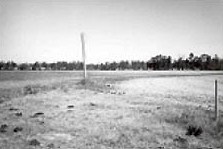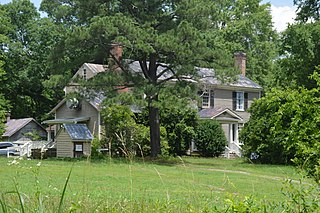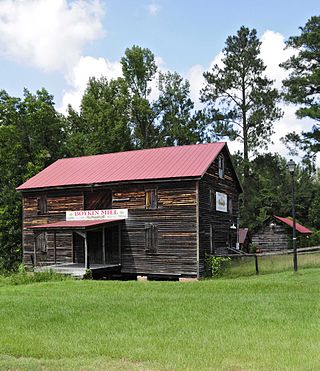
The Charles Pinckney National Historic Site is a unit of the United States National Park Service, preserving a portion of Charles Pinckney's Snee Farm plantation and country retreat. The site is located at 1254 Long Point Road, Mount Pleasant, South Carolina. Pinckney (1757-1824) was a member of a prominent political family in South Carolina. He fought in the American Revolutionary War, was held for a period as prisoner in the North, and returned to the state in 1783. Pinckney, a Founding Father of the United States, served as a delegate to the constitutional convention where he contributed to drafting the United States Constitution.

Galivants Ferry is an unincorporated community in Horry County, South Carolina, United States. It lies on the Little Pee Dee River west of Aynor on U.S. Route 501.

Mansfield Plantation is a well-preserved antebellum rice plantation, established in 1718 on the banks of the Black River in historic Georgetown County, South Carolina.

Coker Experimental Farms, also known as Coker Pedigreed Seed Company, is a National Historic Landmark agricultural site at 1257 South Fourth Street in Hartsville, South Carolina, USA. The property, which is now owned by a museum, was the location where David R. Coker conducted crucial breeding experiments to enhance the strains of cotton and other crops cultivated in the southern United States. Coker was a major force in the development of agricultural extension services in the South in the early decades of the 20th century. What remains of his farm was declared a National Historic Landmark in 1964.

Galivants Ferry Historic District is a national historic district located at Galivants Ferry in Horry County, South Carolina. It encompasses 28 contributing buildings that reflect the agricultural heritage of Galivants Ferry and of the larger Pee Dee region. Included are tenant farmer houses, storage barns, tobacco packhouses, curing barns, and sheds. They include the home of the Holliday family and a church that sits at the edge of a long stretch of tobacco fields on Pee Dee Road. Also included is a filling station along U.S. Route 501. The two-story white brick John Monroe Johnson Holliday House was completed in 1950 and based on a house George Holliday built in the 1920s which burned in 1943. It is described as "owing much to the Colonial Revival and Greek Revival styles."

The Frogmore Plantation Complex, located on Saint Helena Island, in Beaufort County, South Carolina, is significant for several reasons. First, the plantation home, along with its contributing properties, offers an excellent example of the area's architectural development from 1790 to 1920. Second, the plantation's long association with prominent families contributes to its significance. The plantation was first owned by Lieutenant Governor William Bull, who then willed it to his son in 1750.

Sunnyside is a historic plantation house located at Clarksville, Mecklenburg County, Virginia. The house was built in three sections: a one-room, two-story, three-bay frame dwelling with a side passage, built in 1833; a two-story, three bay I-house, begun in 1836 in front of the first dwelling and connected to it by a one-story hyphen; and a two-story, one room, one-bay addition built in 1837. Also on the property are the contributing late-19th century kitchen, an early-to-mid-19th century servant's quarter, an early-to-mid-19th century smokehouse, a mid-19th century shed, an early-20th century chicken house, the site of a 19th-century ice pit, a 19th and early 20th century tenant house / tobacco processing barn, three late 19th or early-20th century log tobacco barns, a 19th-century log tenant house, and the Carrington / Johnson family cemetery.

Colvin–Fant–Durham Farm Complex, also known as the Nicholas Colvin House and Durham House, is a historic home and farm complex and national historic district located near Chester, Chester County, South Carolina. The district encompasses six contributing buildings. The house was built about 1835, and is a vernacular farmhouse with transitional Federal and early Greek Revival detailing. The house consists of a two-story, hall and parlor plan, frame main block and a one-story, frame dining room and kitchen ell, which was added in the late-19th century. The property also includes a smokehouse, well house/power house, mule barn, tenant house, and a log cottonseed house.

Landsford Plantation House, also known as the Davie House, is a historic plantation house located near Richburg, Chester County, South Carolina. It was built about 1828, and is a 2+1⁄2-story, timber-framed weatherboarded vernacular residence. The house has a square plan and is two rooms deep. The main façade featured a one-story porch, resting on brick piers, and added about the turn of the 20th century. Landsford Plantation achieved local prominence as the social center of a 3,000 acres (1,200 ha) Piedmont cotton plantation in the mid-19th century. Of the original outbuildings, only a barn of log construction remains.
Arthur Goodson House, also known as John M. Lide House, is a historic home located at Springville, Darlington County, South Carolina. It was built in the 1850s, and is a 1+1⁄2-story, three-bay, rectangular, central hall, weatherboard-clad, frame residence. The front façade features a full-width, hipped roof porch. Also on the property are two outbuildings, one weatherboard-clad, braced-frame building dating from the antebellum period and one tobacco barn constructed in the late-19th or early-20th century.
Dove Dale, also known as the Archibald Dove House, Daniel Dove House, and Grover Bryant House, is a historic plantation house near Darlington, Darlington County, South Carolina. The original section dates to about 1805, with later 19th- and early 20th-century alterations. It is a 1½-story frame double-pile, spraddle-roofed house. The house features a front porch with six wood piers. A contributing small fish pond is an early landscape feature of the front lawn. Surrounding the house are agricultural fields that have continued under cultivation for over 200 years.

Browntown is a national historic district located near Johnsonville, Florence County, South Carolina. The district encompasses 7 contributing buildings and 4 contributing structures reflecting the self-sufficient way of life practiced by several generations of the Brown family during the 19th and early-20th centuries. Moses Brown and his son and grandsons were self-sufficient farmers who operated their own brick kiln, grist mill, lumber mill, cotton gin, retail and wholesale mercantile business, and school. The property nominated includes the cotton gin building, three residences, the school, a tobacco barn, and several outbuildings. Browntown includes examples of both log and frame construction, and are grouped in two complexes, one group adjacent to the road and the other across the fields around the cotton gin building.
Keithfield Plantation is a historic rice plantation property and national historic district located near Georgetown, Georgetown County, South Carolina. The district encompasses 1 contributing building, 1 contributing site, and 3 contributing structures. They include a slave cabin, built about 1830, and agricultural features including examples of historic ricefields, canals, dikes, and trunks. The original main house burned in the mid-20th century. Keithfield was one of several productive rice plantations on the Black River.
Milldam Rice Mill and Rice Barn, also known as Kinloch Plantation, is a historic rice plantation property and national historic district located near Georgetown, Georgetown County, South Carolina. The district encompasses 1 contributing building, 1 contributing site, and 3 contributing structures. This rice mill and rice barn are associated with Milldam, one of several productive rice plantations on the Santee River. Agricultural features include examples of historic ricefields, including canals, dikes and trunks. The Rice Barn was destroyed by Hurricane Hugo in 1989.

Moore-Kinard House, also known as the J.M.C. Kinard House, is a historic home located near Ninety Six, Greenwood County, South Carolina. It was built about 1835, and is a two-story, frame, antebellum central-hall farmhouse, or I-house. Additions were made to the rear and one side of the house about 1900. Also on the property are the following contributing late-19th or early-20th century outbuildings: a smokehouse, cotton house, tool shed, ironing house, and well.

Boykin Mill Complex, also known as Mill Tract Plantation, is a national historic district located near Camden, Kershaw County, South Carolina. The district encompasses nine contributing buildings, two contributing sites, and four contributing structures. “Boykin Mill” denotes a community which consists of an old post office, an old general store, a c. 1905 grist mill, mill pond, mill dam, gates, and canals. The community also includes an early 19th-century Greek Revival style Baptist church, one mid-19th-century residence, three 20th-century residences built for mill workers, and a smoke house. An American Civil War battle site is also a part of the Boykin Mill community. The Battle of Boykin's Mill took place on April 17, 1865.

Manship Farmstead is a historic farmstead and national historic district located near Tatum, Marlboro County, South Carolina. The district encompasses seven contributing buildings, one contributing site, and one contributing object in an early 20th century agricultural complex. They consist of the main house (1906), outbuildings, a farm bell, the Manship family cemetery, and associated historic rural landscape.
St. Julien Plantation is a historic plantation complex located near Eutawville, Orangeburg County, South Carolina. The plantation house was built about 1854, and is a two-story, L-shaped, vernacular farmhouse with Italianate influences. It features a low-pitched hipped roof with projecting eaves and a bracketed cornice. Also on the property are the contributing log cotton warehouse, board and batten kitchen, Carpenter Gothic mule barn, smokehouse, garage, storage building, and several wood frame farm buildings.
Goodwill Plantation is a historic plantation and national historic district located near Eastover, Richland County, South Carolina. The district encompasses 10 contributing buildings and two contributing structures. They include the millpond and a portion of the canal irrigation system ; the overseer's house ; the 2-1/2-story frame mill building ; two slave cabins ; a blacksmith shop; the late-19th century main house; a lodge ; and a carriage house, tenant house, barn and corn crib.

Hurricane Tavern, also known as Workman Farm, is a national historic district located near Woodruff, Spartanburg County, South Carolina. The district encompasses 30 contributing buildings, 1 contributing site, and 1 contributing structure on a rural farmstead. They include the vernacular Federal style brick farmhouse, built about 1811, with major alterations and additions about 1850 and Bungalow modifications about 1920; a frame farmhouse, a country store, and a collection of late-19th and early-20th century agricultural outbuildings.

















